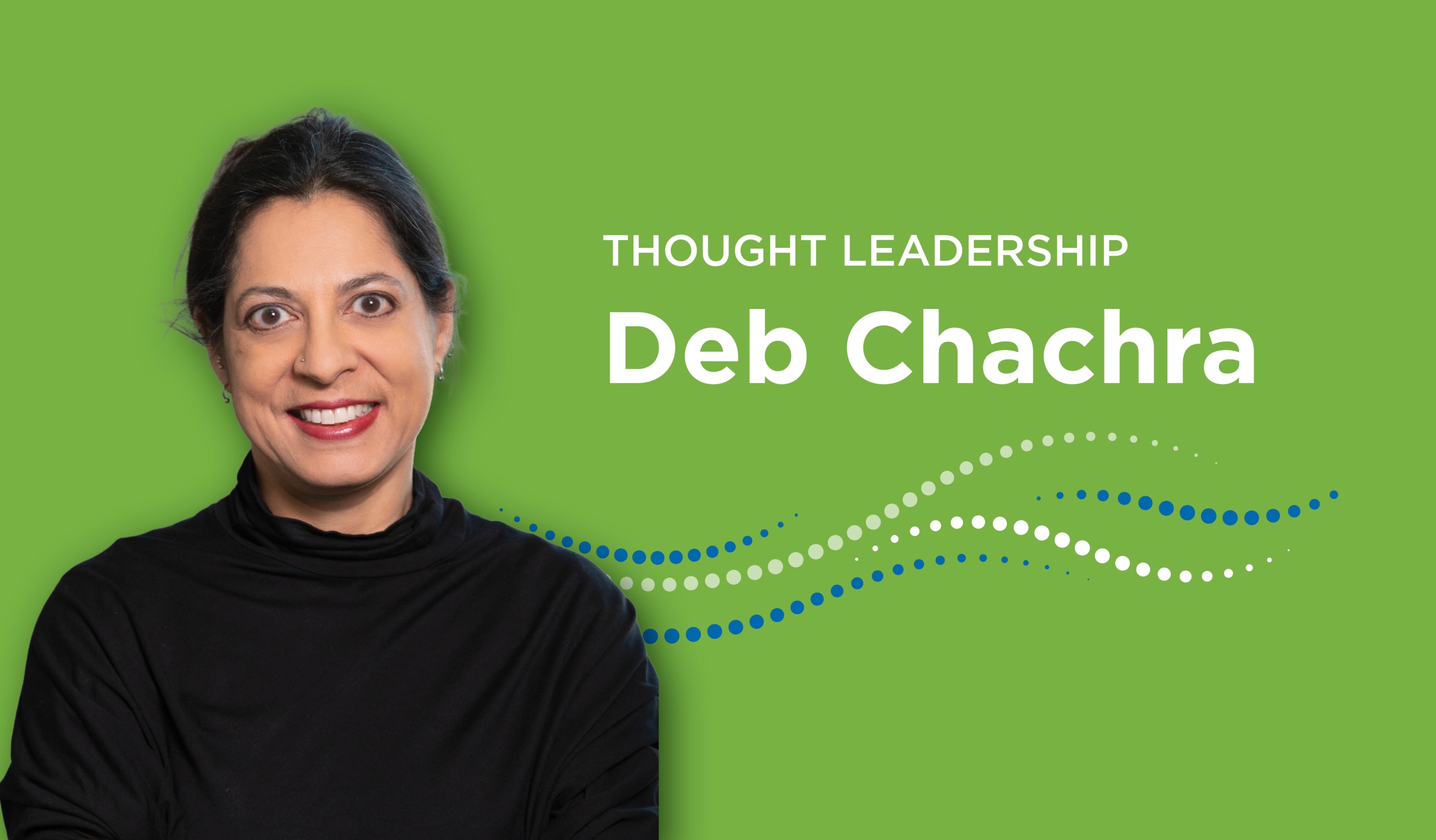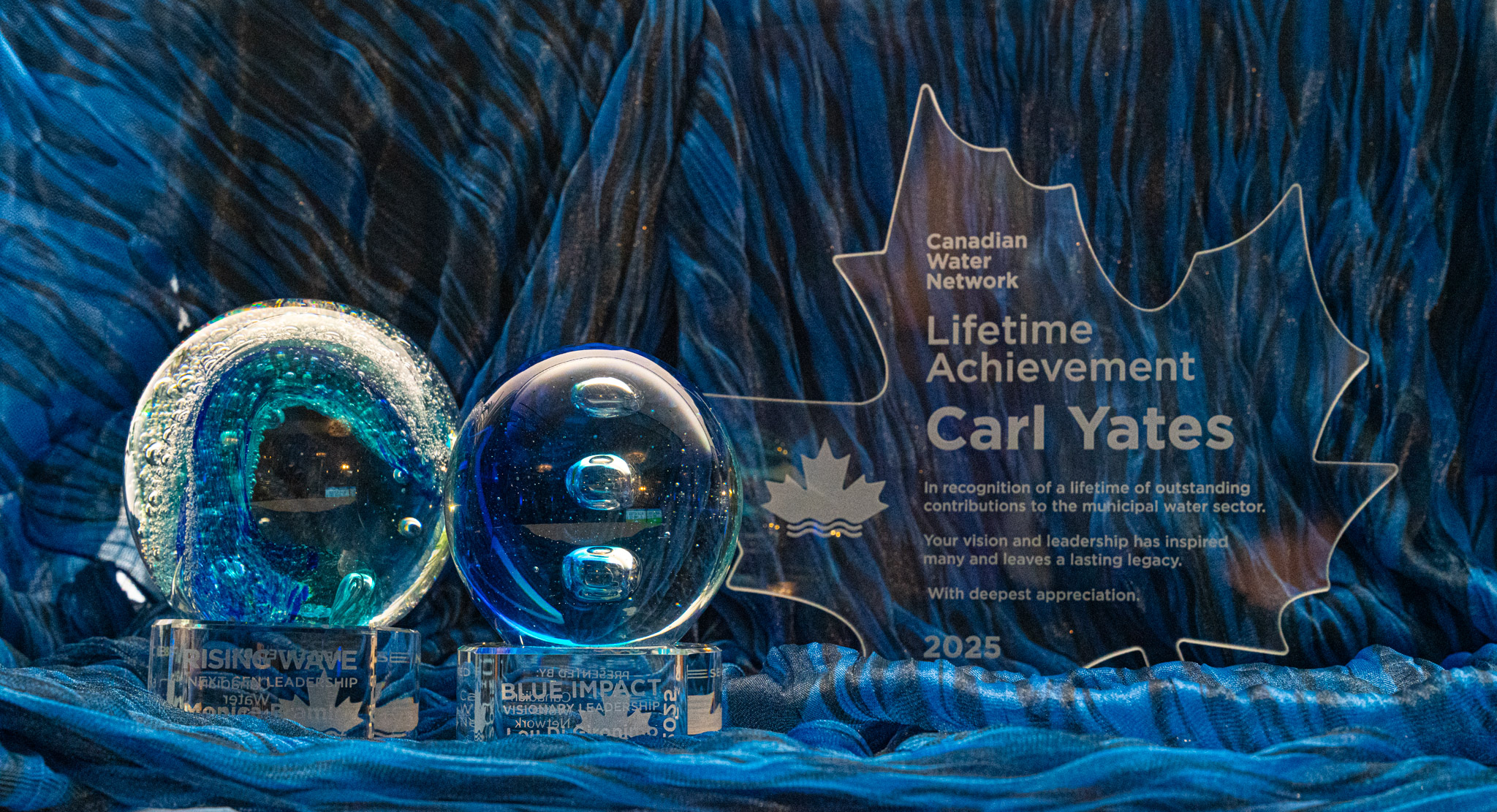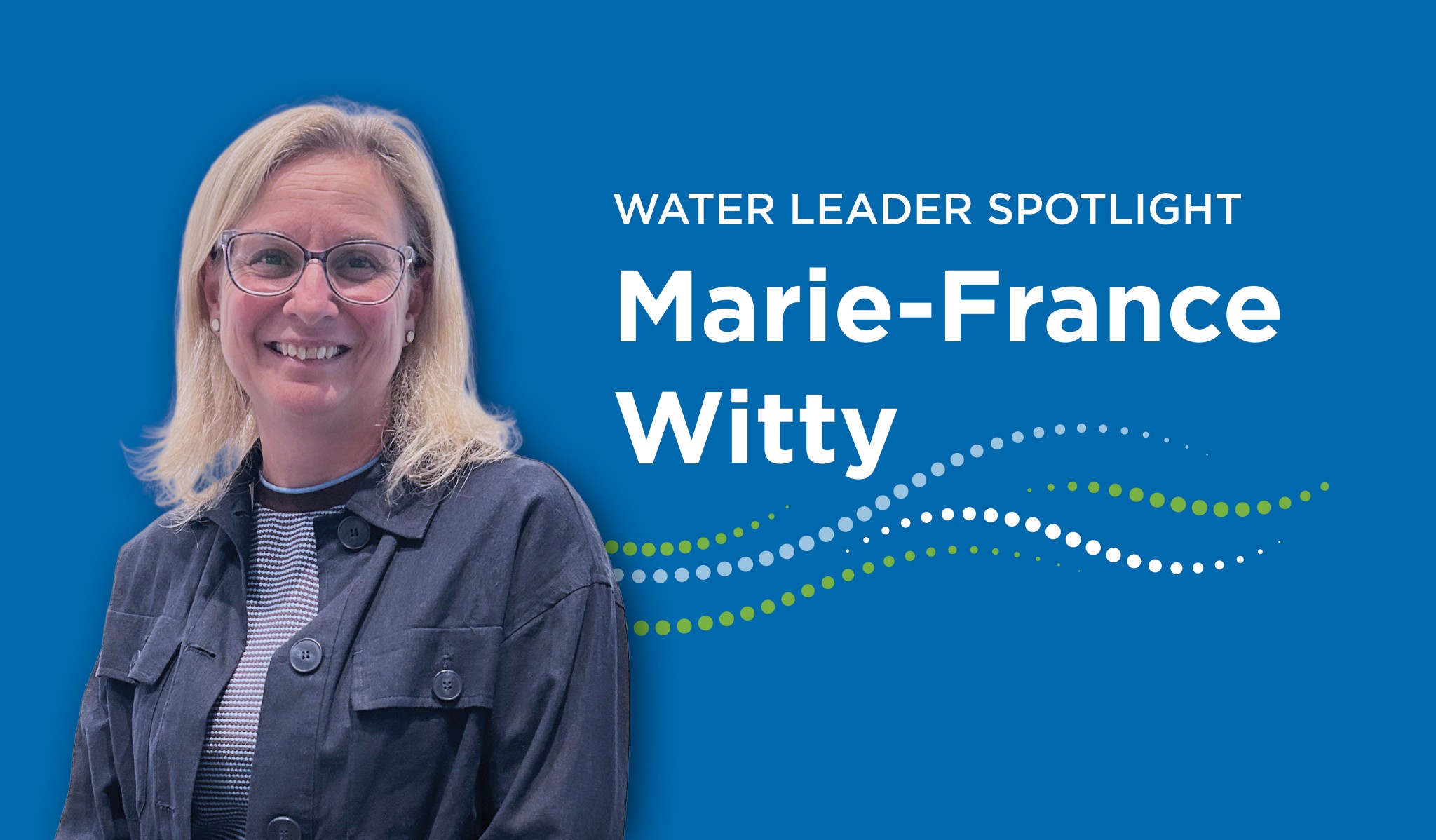Thought Leader Interview – Deb Chachra
March 17, 2025
CWN’s quarterly newsletter with the latest news, insights and thought leadership.

Canadian Water Network’s CEO Nicola Crawhall sat down for an in-depth interview with Dr. Deb Chachra, Blue Cities keynote and Canadian author of How Infrastructure Works: Inside the Systems That Shape Our World.
Dr. Chachra is a professor and materials scientist at Olin College of Engineering in Massachusetts.
What is the significance of the term, “infrastructure citizenship.” What do you mean by this?
Infrastructure citizenship refers to our relationship to each other by virtue of a shared infrastructure network, whether to convey water, gas or electricity, irrespective of political affiliation. When we make upfront investments in infrastructure, the whole of society benefits, establishing a relationship between the people who live in the city — not just in the present, but for years or decades, and potentially centuries to come. Our infrastructure networks connect us to the land where we live, and to the people before, and to the future.
I usually illustrate infrastructure citizenship by talking about water. Any community where people live together figures out how to get clean water and manage sewage. We build out systems that bring clean water to where we live. From a public health perspective, if the people around you don’t have clean water, you may get sick. Everyone benefits from a network that delivers water, because it means that they are less likely to get sick. There is a strong incentive to make sure that everyone has access to that water. This argument prevailed in the late 19th and early 20th centuries to justify massive investments in city-wide, publicly funded infrastructure.
You refer to infrastructure as the physical manifestation of our past and future values of equity and the distribution of benefits and harms.
That’s right. There is the notion of water as a public good, which is derived from economics. But when we hear this term, we normally think of good in the moral sense. South Africa, for example, has written into its constitution that access to water is a human right. And there is a de facto understanding that this is in fact the case everywhere. When talking about affordability or equity, this is the first and most important point — that these are not market goods. The idea that someone can control our access to water like in a Mad Max movie… we recognize it immediately as monstrous.
A second point is that the history of infrastructure networks has largely been about finding ways to provide benefits to the people who are making decisions about infrastructure and those who are benefiting from the infrastructure. Part of that has typically meant figuring out ways to deal with the harms associated with infrastructure and the movement of resources.
As infrastructure systems are very good at moving resources to where they’re used, most of them are also very good at either extracting resources from other places or displacing the harms of those systems to other places. This is most easily demonstrated with electricity. In the 19th century, most energy generation happened close to where you lived, so cities would have heavy polluting coal generating plants in the city. But these plants were moved away to move the pollution out of the city. Another aspect of this harm, of course, is that the coal is being extracted somewhere else, along with the environmental impact of that coal extraction.
This is what I mean when I think about the spatial separation of the benefit and harm of infrastructure, with the people in the city who are building up the coal plant to benefit from the electricity and the harms of displacing the pollution from the energy generation and environmental issues associated with extraction. There are similar patterns with other infrastructure networks, so if you use this framework, you can discern the distribution of who benefits from it, and who is harmed. Up until the second half of the 20th century, harms were displaced by whoever was building the systems. For example, Hydro Quebec dams in northern Quebec displaced First Nations people from their traditional lands.
Transportation networks are interesting from an equity point of view. Highways were built through American cities, typically through African American neighborhoods. These highways were often built for the benefits of people getting from the suburbs to the city centre. Particularly in the U.S. in the mid-20th century, that meant for the benefit of white men. But the people who were dealing with the impacts of living near highways or having their neighborhoods destroyed by highways (or just the noise and the pollution of it) were typically not those groups. There was an uneven distribution of benefits.
One of the stories of the 20th century with respect to North American infrastructure was the change from spatially separating benefits and harms as a result of social movements, like the civil rights movement that gave those who were being systematically harmed by infrastructure networks a stronger political voice to oppose these projects. That changed how we think about building out infrastructure. Suddenly, because of political activism, this typical way of planning who would benefit and where the harms would go, was no longer accepted.
In Boston, the I-90 went through an Italian neighborhood and the I-95 went through Chinatown. Then there was a highway that was going to be built through a historically African American neighborhood. Having seen what happened to these other two places, a coalition of political protests rose up against the project, which actually resulted in a change in federal laws to support transportation generally, not just highways. Where the original highway was proposed, there’s now a covered rail corridor that is a linear park.
Where does climate change fit into equity, benefits and harms?
Up until about 20 years ago, most of our energy came from combustion, i.e., burning fossil fuels. We benefit from this individually. But the harms associated with CO2 in the atmosphere are much more diffuse; they affect everyone on the planet and include people who did not benefit from the energy that was used. In this case, it’s less about displacing, and more about diffusing the harms to everyone. Politically, this is a new world.
We are now moving from the majority of our energy coming from combustion to energy coming from fully renewable sources. This transition really changes the economics of energy. It holds the potential to dramatically change the economics of the cost of mitigating harms. Solar panels on the roofs of houses in a city are generally considered to have minimal negative impacts versus a coal-fired energy generation plant in the middle of your city. Also, renewables-based electricity is becoming much cheaper. Changing the economics of energy really changes the economics of what’s possible in terms of mitigating harms. It makes it more possible to make different decisions about how you’re going to build things and mitigate harms.
A good example of this is closing materials loops. Instead of putting pollution into the atmosphere, we can use abundant cheap renewable energy to recycle or reuse materials, or to reduce or eliminate extraction and the harms associated with extraction. That’s the next step in terms of thinking about infrastructure and equity, and how it is tied to sustainability and resilience.
If we are embedded in infrastructure networks across our landscapes, what does that mean in terms of our individual choices to reduce our carbon footprint?
To decarbonize or reduce our individual carbon footprint, you would need to use significantly less energy if that energy is derived from fossil fuels. Broadly speaking, this would mean that you would do fewer things or do things in different ways. However, the issue here is that most energy usage is not under individual control. Most of our emissions come through shared systems and most of us don’t have a lot of individual choice about where our electricity comes from. We use energy to cook food, warm and cool our houses and for moving around. If you live in a place that doesn’t have good public transit, your only choice for mobility is driving. As a result, it’s difficult to meaningfully affect your carbon footprint as an individual.
This is why companies like British Petroleum (and others) promoted the idea of individual carbon footprints. They really sold the idea that this is your individual problem that you need to figure out how to solve. But it’s not. It’s a collective problem, because it’s really about our shared systems. I’m not saying that you should absolve yourself of any responsibility as an individual, but it’s fundamentally the wrong framing.
The right framing is to understand that most of our energy usage, and therefore most of our fossil fuel usage, and therefore most of our emissions, comes through these collective systems. Then the question becomes, “What do we do with our collective systems and how do we deal with them?” We need to build out shared alternatives to things that are not dependent on individual-level decisions. This is totally doable in a way that it wasn’t even 20 years ago.
Climate change and the need to decarbonize our infrastructure networks is an indisputable game changer. What advice would you give to public infrastructure decision-makers in this era of climate instability about how they build out of transformative infrastructure systems?
My work focuses on how physical networks move resources through the landscape, whether it is water, fuel, electricity or information. With climate change, that landscape is changing, so the networks that we designed and built out — no matter how good a job we did building them — may not work very well anymore. For example, the city of Austin had to issue a boil water order after flooding washed silt into their reservoir and overwhelmed the capacity of the water treatment plant. Austin built good public infrastructure, but they did not build out a water system that could cope with that level of flooding. No matter how good a job we’ve done with our networks in the past, it doesn’t mean that they’re fit for the world of climate instability. It was the same for Hurricane Sandy in New York and the wildfires in Los Angeles.
Because our landscape is no longer stable, the networks that are embedded in our landscape need to be rethought. You can’t just say, “Oh well, it’s going to be fine.” Places will all be affected differently, but they will be affected, whether it’s water scarcity, or water at the wrong time due to early snow melt or flooding. If you’ve built impermeable landscapes, you can’t capture this water — it’s lost and you don’t have access to it. (Mexico City is a good example of this.) You can’t just ignore climate change and be like, “Our system is a good.” Your systems are probably not going to be good enough.
In terms of what to do about it, there is this “big picture” decarbonizing piece. The moral reason to do it, is to reduce carbon dioxide in the atmosphere and slow down climate change. The actual reason to do it, is because in the medium- to long-term, paying for renewables rather than fossil fuels for distribution and operations is going to end up cheaper — no matter how you slice it.
This returns to the idea of infrastructure citizenship. As long as humans exist, and as long as they live near each other, they’re going to need water. We need to be thinking of and planning for infrastructure in perpetuity. The other piece returns to the reason why we built out these systems in the first place: we understand that investing in these systems will actually lead to both monetary and non-monetary returns. You invest to have people who are happier and healthier, who aren’t getting cholera. Health is an intrinsic good — and people who don’t get cholera can be full economic participants. The logic has always been that we invest in infrastructure because it underpins the economic success of where we live.
The reason why infrastructure underpins economic success is because it underpins the ability and agency of people to participate as full economic actors, instead of spending their days dealing with meeting their basic needs. The real reason to adapt your infrastructure systems to climate change, to invest in resilience, is the same reason we built these systems in the first place. It is the single best investment we can make in the success of where we live. Investing in essential infrastructure is investing in the people who live there, and everything else that accrues from that.
If we build infrastructure the way we did 100 or 150 years ago, there will be no functional infrastructure in the future. We need to build infrastructure that is functional, resilient, sustainable and equitable. These objectives are interlinked. It’s going to be really hard to achieve any one of these objectives without investing in all four.
Can you explain the relationship between infrastructure citizenship and ethics of care?
Ethics of care is a philosophical idea. Most infrastructure is implicitly utilitarian and is mediated by money. You want the benefits to outweigh the harms at a reasonable cost. But there’s always been this question of who benefits, and who’s harmed, and what does it mean to outweigh, and what’s a reasonable cost. How do you even put a dollar amount on having electricity or clean water? The thing about this implicit utilitarian approach is that it really depends on who’s making the decisions and what those are. In contrast, care ethics is a philosophy and approach that is focused not solely on who benefits and who harms, but on the idea that we’re in a relationship with each other, and that decisions are made around taking care of each other. Carol Gilligan has written about this.
The advantage of using this framing is that we can say it’s really about things like who are the stakeholders, and who is most vulnerable. It’s about what are the impacts. It’s about being competent at delivering care. It’s about understanding what people need. It’s fun talking about care ethics to people who work in the field of water, because you are already implicitly using this as a model for how you deliver infrastructural systems.
Despite climate instability rendering our infrastructure systems less effective, you are quite optimistic about the future. Why is that?
I’m optimistic because we can now get energy at the scale we need without passing through combustion. Parts of Canada have a big head start on this through hydroelectricity. If all energy has the same economics of hydroelectricity, this opens up a realm of new possibilities for abundant, cheap, renewable energy, combined with closing the materials loop. This energy and materials transition framework, particularly for people who are involved in delivering infrastructure systems, gives them a way of thinking about the work that they do. And for those of us who are not directly involved, it’s a way of thinking and talking about what we want and expect from these systems.
The main thing I say to my engineering students is that now we actually know how to do this. We have paths to a decarbonized future through cheap, abundant renewables like wind, solar, geothermal and hydro — a pathway to a future where energy is the decentralized, distributed public good that it is, rather than having to pass through combustion. We have not wrapped our brain around what it means to have genuinely abundant energy. And when I say abundant, I mean what’s arriving on the planet every day; I’m looking out the window on a sunny day, and it’s right there.
We can actually put that energy to work to deal with the other problem of materials extraction and consumption. We have all these atoms from used materials and processes that have to go somewhere, and many of them are ending up in the wrong place — like CO2 moving in the atmosphere instead of staying under the ground, or microplastics in the oceans. If we have access to energy that basically behaves like sunlight, then this opens a realm of new possibilities for dealing with that kind of environmental degradation.
I tell my students that their job is not to limit the harms of climate change or to deal with all the stuff that’s going bad. Their job is actually to build out this future that is resilient, and sustainable, and equitable, and functional, by harnessing renewable energy and thinking about how to deal with the questions around atoms. It is possible for us to build a world where everyone has access to the agency that’s made possible by energy, where we genuinely start and hopefully make a significant amount of progress in dealing with the environmental harms that are a result of pollution. The thing that’s kind of interesting about this, is that for those who are already working in the field of infrastructure, the things you are doing on a day-to-day basis may be contributing to this transformative work.
~
Thank you, Deb, for sharing your thoughts with our network. To hear more from Dr. Chachra and other leading experts about infrastructure system strategies and solutions, register for Blue Cities on May 14-15 in Mississauga.












